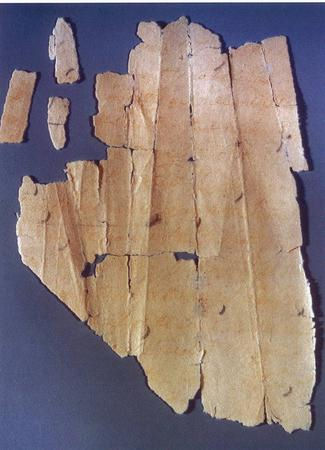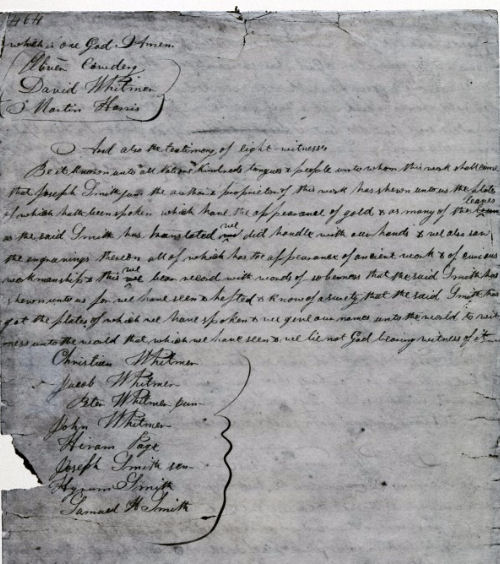
FAIR is a non-profit organization dedicated to providing well-documented answers to criticisms of the doctrine, practice, and history of The Church of Jesus Christ of Latter-day Saints.
Contents |
According to David Whitmer, each of the Three Witnesses added their signatures to the original Book of Mormon manuscript:
In September, 1878, in company with Apostle Orson Pratt, the writer visited David Whitmer, at Richmond, Ray County, Missouri. In the presence of David. C. Whitmer, the son of Jacob, Philander Page, David J. Whitmer, son of David Whitmer, George Scheweich, Col. James W. Black, J. R. B. Van Cleave and some others, Father David Whitmer was asked if the three witnesses signed their own names to their testimony to the Book of Mormon? Father Whitmer unhesitatingly replied with emphasis:
"Yes, we each signed his own name."
"Then," said the questioner, "how is it that the names of all the witnesses are found here, (in D. W's manuscript) written in the same hand writing?"
This question seemed to startle Father Whitmer, and, after examining the signatures he replied:
"Oliver must have copied them."
"Then, where are the original documents?" was asked.
He replied, "I don't know."[1]
Notes
Frederick Kessler stated that he observed Joseph Smith placing the manuscript in the cornerstone of the Nauvoo House:
Further facts in relation to the manuscript of the Book of Mormon. I saw the Prophet Joseph Smith, Jr., hide up the above manuscript unto the Lord in the south-east corner of the Nauvoo House, Illinois. I stood within eight or ten feet of him, heard and saw what he said and did, on that important occasion, which I freely testify to all the world.
[Signed] FREDERICK KESSLER, SEN., Bishop of the Sixteenth Ward, Salt Lake City, Utah. October 12, 1878. [1]
The contents of the cornerstone of the Nauvoo House were the following:
The corner stone of the Nauvoo House was laid by President Joseph Smith on the 2nd of October, 1841, and the following articles were deposited therein by the President, to-wit:
A Book of Mormon; a revelation given January 19, 1841; The Times and Seasons, containing the charter of the Nauvoo House; Journal of Heber C. Kimball; the memorial of Lyman Wight to the United States Senate; a book of Doctrine and Covenants, the first edition; No. 35 of the Times and Seasons; The original manuscript of the Book of Mormon; The Persecutions of the Church in the State of Missouri, published in the Times and Seasons; the Holy Bible. Silver coins as follows: one half-dollar, one quarter-dollar, two dimes, two half-dimes, and one copper coin.[2]
Additional photos of the fragments of the original manuscript that survived may be viewed in Dr. Royal Skousen's presentation "Restoring the Original Text of the Book of Mormon" (5 August 2010).
Royal Skousen describes what happened to the original manuscript,
28 percent of the original manuscript is extant. (In calculating this percentage, I exclude the 116 pages that were lost by Martin Harris in 1828.) In 1841 Joseph Smith placed the original manuscript in the cornerstone of the Nauvoo House, a hotel being built in Nauvoo. And the manuscript lay there in the cornerstone for the next 41 years until in 1882 Lewis Bidamon, the second husband of Emma Smith’s, after her death, retrieved the manuscript. Most of it was severely damaged by water that had seeped in as well as by mold that ate away a lot of the manuscript. Bidamon gave most of the larger manuscript portions to LDS people, and so 25 of that 28 percent has ended up in the archives of the LDS Church. There is half a leaf at the University of Utah. And the equivalent of a leaf in fragments is held privately. Most important for this project has been the discovery of two percent of the text that Wilford Wood bought from Charles Bidamon, the son of Lewis Bidamon, in 1937....[Showing photos of the original manuscript] This is one of the fragments from 2 Nephi 7-8, all rolled up. First, it was unraveled, and you can see on the edges where the mold had eaten away parts of the leaf. You can also see the large water stain in the center, from water that had originally gotten into the cornerstone. After the fragment was leveled and photographed, you can see basically what it is. The text is in the hand of Oliver Cowdery; the ink was originally black and has turned brown over time. [3]

The printer's manuscript was created by Oliver Cowdery to carry to the printer so that the original manuscript would not be lost. This second manuscript is entirely in the handwriting of Oliver Cowdery.
Most critics who make the claim that none of the witnesses signed their testimonies fail to note that one of the witnesses signatures on the printer's manuscript is genuine: that of Oliver Cowdery himself.
Critics of the Church also fail to note that David Whitmer, in fact, made a point of affirming that his testimony was true just as it was printed in the Book of Mormon.

Notes

FAIR is a non-profit organization dedicated to providing well-documented answers to criticisms of the doctrine, practice, and history of The Church of Jesus Christ of Latter-day Saints.
We are a volunteer organization. We invite you to give back.
Donate Now